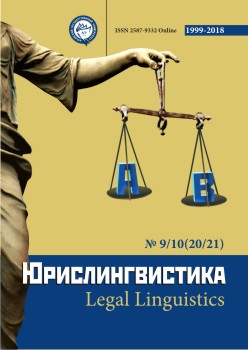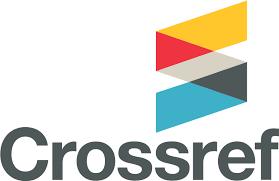SYSTEM-FUNCTIONAL SEMIOTIC APPROACH TO ANALYSIS OF POLICODE TEXT: CURRENT STATE AND FUTURE PERSPECTIVES
Abstract
The significance of study of polycode texts is instigated by their employment for the propaganda of extremist and violent ideas in the Internet communication. The merit of studying poliycode texts is explained by the lack of knowledge about polycode texts in academic science and the weakness of methods for their expertise. It is known that semiotics of polycode text is more heterogeneous than monocode due to conjugation of graphic and verbal types of information. Therefore, modern approaches to the analysis of polycode texts refer to semantic, rather than lexical and grammatical units of text. The theoretical foundations are proposed basing on system-functional semiotics by M. Halliday. Following the provisions, all elements of the polycode text have a specific semiotic meaning. In the analysis, the polycode text is split into modalities of information, and then a complex notion of the whole text is synthesized. In addition, a systematic approach to the assessment of polycode text is based on the assumption that the meanings of the verbal components of the text are complemented by the meanings of the graphic component. Development of the system-functional semiotic approach has two promising perspectives. Firstly, it is overcoming the problems of the conflict of semiotics of heterogeneous information in the text, secondly, defining the role of the reader and understanding his contribution to the interpretation of the meaning of the text.
Downloads
Metrics
References
Антонова Ю.А. и др. Экстремистский текст и деструктивная личность. Урал. гос. пед. ун-т. Екатеринбург, 2014.
Halliday M. A. K. Language as Social Semiotic: The Social Interpretation of Language and Meaning. London: Edward Arnold, 1978.
O’Halloran K.L., Tan S., Wignell P., Bateman J., Pham D.-S., Grossman M., Vande Moere A. Interpreting Text and Image Relations in Violent Extremist Discourse: A Mixed Methods Approach for Big Data Analytics. Terrorism and Political Violence, 2016.
Norris S. Analyzing Multimodal Interaction: A Methodological Framework. London: Routledge, 2004
Forceville C. J. Urios-Aparisi, E. Multimodal Metaphor. Berlin & New York: Mouton de Gruyter, 2009.
REFERENCES
Antonova, Yu. A. and al. Extremist Text and Destructive Personality [Ekstremistskii tekst i destruktivnaya lichnost]. Ural. gos. ped. un-t. Ekaterinburg, 2014.
Halliday M. A. K. Language as Social Semiotic: The Social Interpretation of Language and Meaning. London: Edward Arnold, 1978.
O’Halloran K.L., Tan S., Wignell P., Bateman J., Pham D.-S., Grossman M., Vande Moere A. Interpreting Text and Image Relations in Violent Extremist Discourse: A Mixed Methods Approach for Big Data Analytics. Terrorism and Political Violence, 2016.
Norris S. Analyzing Multimodal Interaction: A Methodological Framework. London: Routledge, 2004
Copyright (c) 2018 Кирилл Витальевич Злоказов

This work is licensed under a Creative Commons Attribution 4.0 International License.
The authors, which are published in this journal, agree to the following conditions:
1. Authors retain the copyright to the work and transfer to the journal the right of the first publication along with the work, at the same time licensing it under the terms of the Creative Commons Attribution License, which allows others to distribute this work with the obligatory indication of the authorship of this work and a link to the original publication in this journal .
2. The authors retain the right to enter into separate, additional contractual agreements for the non-exclusive distribution of the version of the work published by this journal (for example, to place it in the university depository or to publish it in a book), with reference to the original publication in this journal.
3. Authors are allowed to post their work on the Internet (for example, in a university repository or on their personal website) before and during the review process of this journal, as this may lead to a productive discussion, as well as more links to this published work (See The Effect of Open Access).











